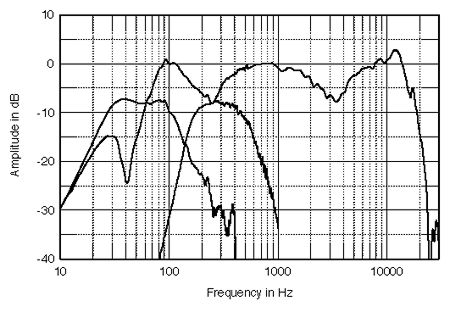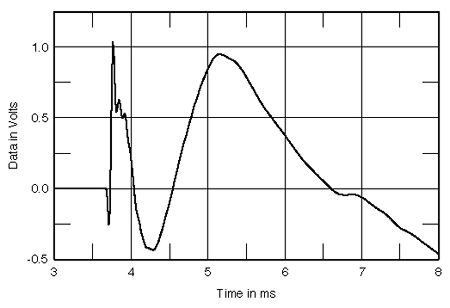| Columns Retired Columns & Blogs |
Monsoon Audio FPF-1000 loudspeaker Measurements
Sidebar 3: Measurements
Footnote 1: All the acoustic measurements were performed using DRA Labs' MLSSA system and calibrated B&K 4006 and Old Colony Mitey Mike 2 microphones. The impedance was assessed using an Audio Precision System One.—John Atkinson
My estimate of the Monsoon Audio FPF-1000's sensitivity was 88.5dB(B)/2.83V/m—fractionally but inconsequentially higher than specified, and a little higher than the average for all the speakers I have measured (footnote 1). The speaker's plot of impedance magnitude and phase against frequency (fig.1), however, revealed it be quite current-hungry. The magnitude hovers around 4 ohms through the upper midrange and low treble, dropping to below 3 ohms in the top two octaves. Perhaps more important is a difficult-to-drive combination of 4.5 ohms and 46 degrees capacitive phase angle at 94Hz, a frequency where music has significant energy.

Fig.1 Monsoon FPF-1000, electrical impedance (solid) and phase (dashed). (2 ohms/vertical div.)
The tuning of the flared reflex port is indicated by the saddle in the magnitude trace at 40Hz, implying only moderate low-frequency extension. The impedance traces appear free from the wrinkles and discontinuities that would imply the presence of cabinet resonances. Nevertheless, a waterfall plot calculated from the output of a plastic-tape accelerometer fastened to the center of the woofer bin's curved sidewall (fig.2) indicated the presence of a mode at 102Hz that might detract slightly from the perceived bass clarity.

Fig.2 Monsoon FPF-1000, cumulative spectral-decay plot of accelerometer output fastened to center of bass-bin side panel. (MLS driving voltage to speaker, 7.55V; measurement bandwidth, 2kHz.)
Turning to the frequency domain, to the right in fig.3 is shown the quasi-anechoic response of the tweeter-midrange section on the tweeter axis, spliced to the nearfield response of the midrange units below 500Hz. There appears to be a classic suckout just below the upper specified crossover frequency on this axis, due to the outputs of the two midrange units and the tweeter being out of phase in the region where they overlap. Further down in frequency, the woofer/midrange transition occurs a little lower in frequency than specified, at 250Hz, with what appear to be fourth-order high- and low-pass filter slopes. The woofers peak a bit before descending to the minimum-motion frequency of 40Hz, as expected from the impedance plot. The port, however, covers a slightly broader range than expected.

Fig.3 Monsoon FPF-1000, acoustic crossover on tweeter axis at 50", corrected for microphone response, with the nearfield midrange, woofer, and port responses plotted below 500Hz, 1kHz, and 400Hz, respectively.
Fig.4 shows how these individual responses sum on the tweeter axis. The overall response trend is flat but, again, the suckout between 2kHz and 6kHz is apparent. So is a similar suckout in the lower crossover region. (I confirmed this calculated response by examining the farfield response using pink noise.) As with the Joseph Audio RM33si Signature, also reviewed in this issue, predicting the subjective effect of the lack of integration through the midrange/woofer transition is tricky because this is also the region where room acoustics have a profound effect on a speaker's balance. If you do suspect a lack of "power" in the in-room balance, you could try inverting the polarity of the woofer section, this made trivially easy with the biwiring terminals. I do note, however, that KR was bothered by the FPF-1000's behavior in this region.

Fig.4 Monsoon FPF-1000, anechoic response on tweeter axis at 50", averaged across 30 degrees horizontal window and corrected for microphone response, with the complex sum of nearfield midrange, woofer, and port responses plotted below 300Hz.
The port doesn't appear to do much in the way of extending the Monsoon's bass output, the speaker rolling off smoothly below the upper bass. In-room, the midbass will come up a little, but, as KR noted, there will be no low bass worth speaking of.
Looking at the dispersion in the vertical plane (fig.5; just the differences in response are shown), it is apparent that the tweeter axis is not optimal. The upper crossover suckout does fill in for listeners who sit with their ears level with either of the midrange drivers. Nevertheless, I suspect that this suckout leaves the tweeter a little isolated, which is why KR found the sound of small bells to emanate directly from the tweeter positions. In the horizontal plane (fig.6), the midrange units become quite directional at the top of their passband, while the tweeter has very wide dispersion at the bottom of its passband. In a typical room, this presence-region "flare" will tend to compensate subjectively for the FPF-1000's lack of on-axis energy in the same region. Note also that the top octaves are more extended to the speaker's sides than they are on-axis, which is probably why Kal ended up without the speakers toed-in to the listening position.

Fig.5 Monsoon FPF-1000, vertical response family at 50", from back to front: differences in response 15 degrees–5 degrees above tweeter axis, reference response, differences in response 5 degrees–10 degrees below tweeter axis.

Fig.6 Monsoon FPF-1000, lateral response family at 50", from back to front: differences in response 90 degrees–5 degrees off-axis, reference response, differences in response 5 degrees–90 degrees off-axis.
The Monsoon's step response (fig.7) indicates that the tweeter is connected with inverted acoustic polarity—see the sharp negative-going spike just after the 3.5ms mark—with then the midrange units and woofers following in positive polarity. Looking at the individual step responses of the two sections (fig.8) reveals the phase difference between the woofers (blue trace) and the midrange units (red), which leads to the on-axis suckout in the lower crossover region. The woofers' output starts to go positive at the same time (the 4ms mark) that the midrange units' output is crossing the time axis in the negative direction. It is only later that the outputs of all four drive-units are in phase.

Fig.7 Monsoon FPF-1000, step response on tweeter axis at 50" (5ms time window, 30kHz bandwidth).

Fig.8 Monsoon FPF-1000, step responses of woofers (blue) and midrange units (red) on tweeter axis at 50" (5ms time window, 30kHz bandwidth).
Finally, the FPF-1000's cumulative spectral-decay plot on the tweeter axis (fig.9) is clean throughout the treble region, though a slight discontinuity at the top of the midrange units' passband might hint at occasional nasality.—John Atkinson

Fig.9 Monsoon FPF-1000, cumulative spectral-decay plot at 50" (0.15ms risetime).
Footnote 1: All the acoustic measurements were performed using DRA Labs' MLSSA system and calibrated B&K 4006 and Old Colony Mitey Mike 2 microphones. The impedance was assessed using an Audio Precision System One.—John Atkinson
- Log in or register to post comments




































